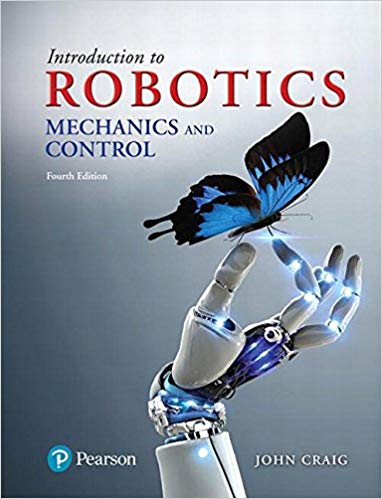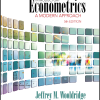Solution manual for Introduction to Robotics Mechanics and Control 4th Edition by John Craig ISBN 9780133489835 0133489833
$70.00 Original price was: $70.00.$35.00Current price is: $35.00.
Instant download (Solution manual) Introduction to Robotics Mechanics and Control 4th Edition John J. Craig after payment
Solution manual for Introduction to Robotics Mechanics and Control 4th Edition by John Craig – Ebook PDF Instant Download/Delivery: 9780133489835 ,0133489833
Full dowload Solution manual for Introduction to Robotics Mechanics and Control 4th Edition after payment

Product details:
ISBN 10: 0133489833
ISBN 13: 9780133489835
Author: John Craig
This is the eBook of the printed book and may not include any media, website access codes, or print supplements that may come packaged with the bound book. For senior-year undergraduate and first-year graduate courses in robotics. An intuitive introduction to robotic theory and application Since its original publication in 1986, Craig’s Introduction to Robotics: Mechanics and Control has been the leading textbook for teaching robotics at the university level. Blending traditional mechanical engineering material with computer science and control theoretical concepts, the text covers a range of topics, including rigid-body transformations, forward and inverse positional kinematics, velocities and Jacobians of linkages, dynamics, linear and non-linear control, force control methodologies, mechanical design aspects, and robotic programming. The 4th Edition features a balance of application and theory, introducing the science and engineering of mechanical manipulation–establishing and building on foundational understanding of mechanics, control theory, and computer science. With an emphasis on computational aspects of problems, the text aims to present material in a simple, intuitive way.
Solution manual for Introduction to Robotics Mechanics and Control 4th Edition Table of contents:
Chapter 1 Introduction
1.1 Background
1.2 The Mechanics and Control of Mechanical Manipulators
Description of Position and Orientation
Forward Kinematics of Manipulators
Inverse Kinematics of Manipulators
Velocities, Static Forces, Singularities
Dynamics
Trajectory Generation
Manipulator Design and Sensors
Linear Position Control
Nonlinear Position Control
Force Control
Programming Robots
Off-Line Programming and Simulation
1.3 Notation
Bibliography
General-Reference Books
General-Reference Journals and Magazines
Exercises
Programming Exercise (Part 1)
Matlab Exercise 1
Chapter 2 Spatial Descriptions and Transformations
2.1 Introduction
2.2 Descriptions: Positions, Orientations, and Frames
Description of a Position
Description of an Orientation
Description of a Frame
2.3 Mappings: Changing Descriptions from Frame to Frame
Mappings Involving Translated Frames
Mappings Involving Rotated Frames
Mappings Involving General Frames
2.4 Operators: Translations, Rotations, and Transformations
Translational Operators
Rotational Operators
Transformation Operators
2.5 Summary of Interpretations
2.6 Transformation Arithmetic
Compound Transformations
Inverting a Transform
2.7 Transform Equations
2.8 More on Representation of Orientation
X–Y–Z Fixed Angles
Z–Y–X Euler Angles
Z–Y–Z Euler Angles
Other Angle-Set Conventions
Equivalent Angle–Axis Representation
Euler Parameters
Taught and Predefined Orientations
2.9 Transformation of Free Vectors
2.10 Computational Considerations
Bibliography
Exercises
Programming Exercise (Part 2)
Matlab Exercise 2A
Matlab Exercise 2B
Chapter 3 Manipulator Kinematics
3.1 Introduction
3.2 Link Description
3.3 Link-Connection Description
Intermediate Links in the Chain
First and Last Links in the Chain
Link Parameters
3.4 Convention for Affixing Frames to Links
Intermediate Links in the Chain
First and Last Links in the Chain
Summary of the Link Parameters in Terms of the Link Frames
Summary of Link-Frame Attachment Procedure
3.5 Manipulator Kinematics
Derivation of Link Transformations
Concatenating Link Transformations
3.6 Actuator Space, Joint Space, and Cartesian Space
3.7 Examples: Kinematics of Two Industrial Robots
The PUMA 560
The Yasukawa Motoman L-3
3.8 Frames with Standard Names
The Base Frame, {B}
The Station Frame, {S}
The Wrist Frame, {W}
The Tool Frame, {T}
The Goal Frame, {G}
3.9 Where is the Tool?
3.10 Computational Considerations
Bibliography
Exercises
Programming Exercise (Part 3)
Matlab Exercise 3
Chapter 4 Inverse Manipulator Kinematics
4.1 Introduction
4.2 Solvability
Existence of Solutions
Multiple Solutions
Method of Solution
4.3 The Notion of Manipulator Subspace When n<6
4.4 Algebraic vs. Geometric
Algebraic Solution
Geometric Solution
4.5 Algebraic Solution by Reduction to Polynomial
4.6 Pieper’s Solution When Three Axes Intersect
4.7 Examples of Inverse Manipulator Kinematics
The Unimation PUMA 560
The Yasukawa Motoman L-3
4.8 The Standard Frames
4.9 Solve-ing a Manipulator
4.10 Repeatability and Accuracy
4.11 Computational Considerations
Bibliography
Exercises
Programming Exercise (Part 4)
Matlab Exercise 4
Chapter 5 Jacobians: Velocities and Static Forces
5.1 Introduction
5.2 Notation for Time-Varying Position and Orientation
Differentiation of Position Vectors
The Angular Velocity Vector
5.3 Linear and Rotational Velocity of Rigid Bodies
Linear Velocity
Rotational Velocity
Simultaneous Linear and Rotational Velocity
5.4 More on Angular Velocity
A Property of the Derivative of an Orthonormal Matrix
Velocity of a Point Due to Rotating Reference Frame
Skew-Symmetric Matrices and the Vector Cross-Product
Gaining Physical Insight Concerning the Angular-Velocity Vector
Other Representations of Angular Velocity
5.5 Motion of the Links of a Robot
5.6 Velocity “Propagation” from Link to Link
5.7 Jacobians
Changing a Jacobian’s Frame of Reference
5.8 Singularities
5.9 Static Forces in Manipulators
5.10 Jacobians in the Force Domain
5.11 Cartesian Transformation of Velocities and Static Forces
Bibliography
Exercises
Programming Exercise (Part 5)
Matlab Exercise 5
Chapter 6 Manipulator Dynamics
6.1 Introduction
6.2 Acceleration of a Rigid Body
Linear Acceleration
Angular Acceleration
6.3 Mass Distribution
6.4 Newton’s Equation, Euler’s Equation
Newton’s Equation
Euler’s Equation
6.5 Iterative Newton Euler Dynamic Formulation
Outward Iterations to Compute Velocities and Accelerations
The Force and Torque Acting on a Link
Inward Iterations to Compute Forces and Torques
The Iterative Newton–Euler Dynamics Algorithm
Inclusion of Gravity Forces in the Dynamics Algorithm
6.6 Iterative vs. Closed Form
6.7 An Example of Closed-Form Dynamic Equations
6.8 The Structure of a Manipulator’s Dynamic Equations
The State-Space Equation
The Configuration-Space Equation
6.9 Lagrangian Formulation of Manipulator Dynamics
6.10 Formulating Manipulator Dynamics in Cartesian Space
The Cartesian State-Space Equation
The Cartesian Configuration Space Torque Equation
6.11 Inclusion of Nonrigid Body Effects
6.12 Dynamic Simulation
6.13 Computational Considerations
A Historical Note Concerning Efficiency
Efficiency of Closed Form vs. that of Iterative Form
Efficient Dynamics for Simulation
Memorization Schemes
Bibliography
Exercises
Programming Exercise (Part 6)
Matlab Exercise 6A
Matlab Exercise 6B
Matlab Exercise 6C
Chapter 7 Trajectory Generation
7.1 Introduction
7.2 General Considerations in Path Description and Generation
7.3 Joint-Space Schemes
Cubic Polynomials
Cubic Polynomials for a Path with via Points
Higher-Order Polynomials
Linear Function with Parabolic Blends
Linear Function with Parabolic Blends for a Path with via Points
7.4 Cartesian-Space Schemes
Cartesian Straight-Line Motion
7.5 Geometric Problems with Cartesian Paths
Problems of Type 1: Intermediate Points Unreachable
Problems of Type 2: High Joint Rates Near Singularity
Problems of Type 3: Start and Goal Reachable in Different Solutions
7.6 Path Generation at Run Time
Generation of Joint-Space Paths
Generation of Cartesian-Space Paths
7.7 Description of Paths with a Robot Programming Language
7.8 Planning Paths When Using the Dynamic Model
7.9 Collision-Free Path Planning
Bibliography
Exercises
Programming Exercise (Part 7)
Matlab Exercise 7
Chapter 8 Manipulator-Mechanism Design
8.1 Introduction
8.2 Basing the Design on Task Requirements
Number of Degrees of Freedom
Workspace
Load Capacity
Speed
Repeatability and Accuracy
8.3 Kinematic Configuration
Cartesian
Articulated
SCARA
Spherical
Cylindrical
Wrists
8.4 Quantitative Measures of Workspace Attributes
Efficiency of Design in Terms of Generating Workspace
Designing Well-Conditioned Workspaces
8.5 Redundant and Closed-Chain Structures
Micromanipulators and Other Redundancies
Closed-Loop Structures
8.6 Actuation Schemes
Actuator Location
Reduction and Transmission Systems
8.7 Stiffness and Deflections
Flexible Elements in Parallel and in Series
Shafts
Gears
Belts
Links
Actuators
8.8 Position Sensing
8.9 More on Optical Encoders
8.10 Force Sensing
Force-Sensor Design Issues
Bibliography
Exercises
Programming Exercise (Part 8)
Matlab Exercise 8
Chapter 9 Linear Control of Manipulators
9.1 Introduction
9.2 Feedback and Closed-Loop Control
9.3 Second-Order Linear Systems
Real and Unequal Roots
Complex Roots
Real and Equal Roots
9.4 Control of Second-Order Systems
9.5 Control-Law Partitioning
9.6 Trajectory-Following Control
9.7 Disturbance Rejection
Steady-State Error
Addition of an Integral Term
9.8 Continuous vs. Discrete Time Control
9.9 Modeling and Control of a Single Joint
Motor-Armature Inductance
Effective Inertia
Unmodeled Flexibility
Estimating Resonant Frequency
Control of a Single Joint
9.10 Architecture of an Industrial-Robot Controller
Bibliography
Exercises
Programming Exercise (Part 9)
Matlab Exercise 9
Chapter 10 Nonlinear Control of Manipulators
10.1 Introduction
10.2 Nonlinear and Time-Varying Systems
10.3 Multi-Input, Multi-Output Control Systems
10.4 The Control Problem for Manipulators
10.5 Practical Considerations
Time Required to Compute the Model
Feedforward Nonlinear Control
Dual-Rate Computed-Torque Implementation
Lack of Knowledge of Parameters
10.6 Current Industrial-Robot Control Systems
Individual-Joint PID Control
Addition of Gravity Compensation
Various Approximations of Decoupling Control
10.7 Lyapunov Stability Analysis
10.8 Cartesian-Based Control Systems
Comparison with Joint-Based Schemes
Intuitive Schemes of Cartesian Control
Cartesian Decoupling Scheme
10.9 Adaptive Control
Bibliography
Exercises
Programming Exercise (Part 10)
Chapter 11 Force Control of Manipulators
11.1 Introduction
11.2 Application of Industrial Robots to Assembly Tasks
11.3 A Framework for Control in Partially Constrained Tasks
11.4 The Hybrid Position/Force Control Problem
11.5 Force Control of a Mass Spring System
11.6 The Hybrid Position/Force Control Scheme
A Cartesian Manipulator Aligned with {C}
A General Manipulator
Adding Variable Stiffness
11.7 Current Industrial-Robot Control Schemes
Passive Compliance
Compliance through Softening Position Gains
Force Sensing
Bibliography
Exercises
Programming Exercise (Part 11)
Chapter 12 Robot Programming Languages and Systems
12.1 Introduction
12.2 The Three Levels of Robot Programming
Teach by Showing
Explicit Robot Programming Languages
Task-Level Programming Languages
12.3 A Sample Application
12.4 Requirements of a Robot Programming Language
World Modeling
Motion Specification
Flow of Execution
Programming Environment
Sensor Integration
12.5 Problems Peculiar to Robot Programming Languages
Internal World Model versus External Reality
Context Sensitivity
Error Recovery
Bibliography
Exercises
Programming Exercise (Part 12)
Chapter 13 Off-Line Programming Systems
13.1 Introduction
13.2 Central Issues in OLP Systems
User Interface
3-D Modeling
Kinematic Emulation
Path-Planning Emulation
Dynamic Emulation
Multiprocess Simulation
Simulation of Sensors
Language Translation to Target System
Workcell Calibration
13.3 The ‘Pilot’ Simulator
Physical Modeling and Interactive Systems
Geometric Algorithms for Part Tumbling
Stable-State Probabilities
Adjusting Probabilities as a Function of Drop Height
Simulation of Bounce
Simulation of Stacking and Tangling
Geometric Algorithms for Part Grasping
Computing Which Part to Grasp
Computation of Default Grasp Location
Computation of Alignment of the Part During Grasp
Geometric Algorithms for Part Pushing
Geometric Algorithms for Tray Conveyors
Connecting Tray Conveyors and Sources and Sinks
Pushing of Trays
Geometric Algorithms for Sensors
Proximity Sensors
2-D Vision Systems
Inspector Sensors
Conclusion
13.4 Automating Subtasks in OLP Systems
Automatic Robot Placement
Collision Avoidance and Path Optimization
Automatic Planning of Coordinated Motion
Force-Control Simulation
Automatic Scheduling
Automatic Assessment of Errors and Tolerances
Bibliography
Exercises
Programming Exercise (Part 13)
Appendix A Trigonometric Identities
Appendix B The 24 Angle-Set Conventions
Appendix C Some Inverse-Kinematic Formulas
Solutions to Selected Exercises
Chapter 2 Spatial Descriptions and Transformations Exercises
Chapter 3 Manipulator Kinematics Exercises
Chapter 5 Jacobians: Velocities and Static Forces Exercises
Chapter 6 Manipulator Dynamics Exercises
Chapter 7 Trajectory Generation Exercises
Chapter 10 Nonlinear Control of Manipulators Exercises
Chapter 11 Force Control of Manipulators Exercises
Index
People also search for Solution manual for Introduction to Robotics Mechanics and Control 4th Edition:
introduction to robotics mechanics and control 4th edition
introduction to robotics mechanics and control 4th edition pdf
introduction to robotics mechanics and control by john craig
borrow introduction to robotics mechanics and control


